| |
Causes of Death among Persons with AIDS in the Era of Highly Active Antiretroviral Therapy: New York City
|
| |
| |
Judith E. Sackoff, PhD; David B. Hanna, MS; Melissa R. Pfeiffer, MPH; and Lucia V. Torian, PhD
Annals of Internal Medicine
19 September 2006 | Volume 145 Issue 6 | Pages 397-406
"....in our population-based analysis of deaths among persons with AIDS in New York City, the proportion of deaths due to non-HIV-related causes increased by 33% between 1999 and 2004. Most of the non-HIV-related deaths were due to substance abuse, cardiovascular disease, and cancer, and many of them were preventable. Achieving reductions in non-HIV-related deaths may require a shift in the health care model for persons with AIDS from a primary focus on managing HIV infection to providing care that addresses all aspects of physical and mental health...
.... Drug abuse and dependence (that is, overdose), chronic ischemic heart disease, lung cancer, hypertension, alcohol abuse and dependence, and hepatitis C were leading causes in most groups, although mortality rates also varied statistically significantly by sociodemographic characteristics and transmission category...."
Note from Jules Levin: when looking at age groups (table 4), in the 45-54 age group: hepatitis C and liver cancer together - 10.9 deaths per 10,000 - this was the third leading cause in deaths/10,000 after substance abuse, a catch-all category (22.5 per 10,000), and cardiovascular disease, 14.8 deaths per 10,000. In the 55-64 age group the collective deaths for HCV & liver cancer was again 10.9 per 10,000).
Editor's Notes:
* As HIV treatment becomes more effective, AIDS-related deaths are decreasing and HIV-infected patients are dying of other causes. Better information about these other causes will help to determine appropriate health care for this population.
* The authors used death certificates to identify the causes of death in 68 669 residents of New York City reported with AIDS. The percentage of deaths from non-HIV-related causes increased from 19.8% to 26.3% between 1999 and 2004. The principal causes of non-HIV-related deaths were cardiovascular disease, substance abuse, and non-AIDS-defining cancer.
Cautions: * Death certificates are an imperfect way to identify cause of death.
Implications:
* Health care for HIV-infected patients must include prevention and management of common diseases as well as HIV-focused care.
ABSTRACT
Background: Monitoring the full spectrum of causes of death among persons with AIDS is increasingly important as survival improves because of highly active antiretroviral therapy.
Objective: To describe recent trends in deaths due to HIV-related and non-HIV-related causes among persons with AIDS, identify factors associated with these deaths, and identify leading causes of non-HIV-related deaths.
Design: Population-based cohort analysis.
Setting: New York City.
Patients: All adults (age 13 years) living with AIDS between 1999 and 2004 who were reported to the New York City HIV/AIDS Reporting System and Vital Statistics Registry through 2004 (n = 68 669).
Measurements: Underlying cause of death on the death certificate.
Results:
Between 1999 and 2004, the percentage of deaths due to non-HIV-related causes increased by 32.8% (from 19.8% to 26.3%; P = 0.015).
The age-adjusted mortality rate decreased by 49.6 deaths per 10 000 persons with AIDS (P < 0.001) annually for HIV-related causes but only by 7.5 deaths per 10 000 persons with AIDS (P = 0.004) annually for non-HIV-related causes.
Of deaths due to non-HIV-related causes, 76% could be attributed to substance abuse (HCv, liver cancer & cirrhosis are included in substance abuse category), cardiovascular disease, or a non-AIDS-defining type of cancer.
Compared with men who have sex with men, injection drug users had a statistically significantly increased risk for death due to HIV-related causes (hazard ratio, 1.59 [95% CI, 1.49 to 1.70]) and non-HIV-related causes (hazard ratio, 2.54 [CI, 2.24 to 2.87]).
Limitations: Compared with autopsy and chart review, death certificates may lack specificity in the underlying cause of death or detailed clinical and treatment-related information.
Conclusions: Non-HIV-related causes of death account for one fourth of all deaths of persons with AIDS. Cardiovascular disease, non-AIDS-defining cancer, and substance abuse account for most non-HIV-related deaths. Reducing deaths from these causes requires a shift in the health care model for persons with AIDS from a primary focus on managing HIV infection to providing care that addresses all aspects of physical and mental health.
Introduction
Over the past 20 years, AIDS has been transformed from a disease that was almost inevitably fatal to a chronic condition that is manageable for many people in the United States (1). The evolution began modestly in the early 1990s with prophylaxis against common opportunistic illnesses and accelerated in the mid-1990s with the introduction of protease inhibitors and highly active antiretroviral therapy (HAART). Between 1996 and 1998, HIV-related morbidity and mortality decreased by 60% in the United States (2-4).
Along with increases in survival, the spectrum of underlying causes of death among persons with AIDS has gradually shifted. Between 1987 and 1999, the proportion of deaths due to non-HIV-related causes increased from 10.6% to 22.9% in 2 U.S. metropolitan areas (5). The most common non-HIV-related causes of death reported in the literature are alcohol and drug dependence, cardiovascular disease, and non-HIV-related cancer (6-9). The distribution of these causes varies with the sociodemographic characteristics of the persons studied, notably the prevalence of injection drug use (10-12). In recognition of the increasing importance of non-HIV-related causes of death, the Infectious Diseases Society of America (IDSA) has argued that health care for people with HIV infection should expand from a primary focus on HIV-related illnesses to include preventable conditions that account for an increasing proportion of deaths (13). Thus, analyses that contribute to a fuller understanding of the underlying causes of death in subpopulations of persons with AIDS are needed. Many previous analyses are limited by small sample size, lack of generalizability, a focus on specific causes of death, and a failure to distinguish between deaths of persons with AIDS and deaths of persons with HIV infection (non-AIDS) (8, 14-19).
New York City is the single largest HIV/AIDS-reporting jurisdiction in the United States, accounting for 15.3% of AIDS cases and 16.4% of deaths among persons with AIDS (20). Thus, we had a unique opportunity to conduct a population-based analysis of the spectrum of underlying causes of death in a large and heterogeneous population. The data are drawn from 2 population-based registries, the New York City HIV/AIDS Reporting System and Vital Statistics Registry, and cover the period of 1999 through 2004.
Methods
Population
The population was made up of persons 13 years of age or older who received; a diagnosis of AIDS; were alive at any time between 1999 and 2004; were reported to the New York City HIV/AIDS Reporting System as of 30 September 2005; were residents of New York City at the time of diagnosis; and, among those who died, had a known underlying cause of death (98.2% of all deaths).
Data Sources
The New York City HIV/AIDS Reporting System is a population-based registry of persons who received a diagnosis of AIDS (beginning in 1981), as defined by the Centers for Disease Control and Prevention (CDC), or HIV infection (non-AIDS) (beginning in 2000) (21). The current AIDS case definition includes a positive test result for HIV plus 1 or more of 26 opportunistic illnesses or a CD4+ lymphocyte count less than 0.200 x 109 cells/L or less than 14% of total lymphocytes. The New York City HIV/AIDS Reporting System receives reports of possible AIDS diagnoses through an electronic laboratory reporting system or physician reports and investigates them by chart review. Reporting of AIDS in New York City is estimated to be 95% complete (22).
The vital status of persons with AIDS is ascertained by semiannual matches between the HIV/AIDS Reporting System and the Vital Statistics Registry. The underlying cause of death is coded at the New York City Department of Health and Mental Hygiene (DOHMH) Office of Vital Statistics by a nosologist who is certified by the National Center for Health Statistics. The nosologist codes the cause of death using the International Statistical Classification of Diseases and Related Health Problems, 10th Revision (ICD-10) (23).
We classified persons as living in an area of poverty if they lived in a ZIP code-tabulation area with more than 20% of the population below the 1999 federal poverty level or if they were homeless (24). All other variables were patient-level and were collected as part of routine surveillance. We derived demographic data from medical record reviews and provider reports and computed age at the end of 2004 or at the time of death for persons who died. We classified race or ethnicity as Hispanic, black (non-Hispanic), white (non-Hispanic), or other or unknown. The HIV transmission categories were injection drug use, men who have sex with men, and high-risk heterosexual sex. The high-risk heterosexual category included heterosexual sex with a partner who had HIV infection, with an injection drug user, or with a bisexual man. We classified men who were injection drug users and who had sex with men as injection drug users. Otherwise, when more than 1 risk factor was reported, we classified persons on the basis of the CDC hierarchy of transmission categories (25). We defined borough as the borough of residence at the time of AIDS diagnosis. We grouped the year of the AIDS diagnosis into 3 periods: pre-HAART (before 1996), early HAART (1996-1998), and late HAART (1999-2004). We obtained CD4+ lymphocyte counts primarily through an electronic laboratory reporting system. The CD4+ lymphocyte count used in the analysis was the lowest count in the second half of 2004 or within 6 months of death.
Outcome
The outcome was the underlying cause of death. Persons with an unknown underlying cause of death (n = 233 [1.8%]) were excluded from cause-specific analyses.
HIV-Related Underlying Causes of Death
We classified deaths as HIV-related if the ICD-10 code for the underlying cause of death was between B20 and B24 (HIV disease) or if the ICD-10 code was for an opportunistic illness in the CDC case definition. The latter criterion ensured that we did not misclassify deaths of people with AIDS as non-HIV-related because HIV was not mentioned on the death certificate (26). We did not further categorize these deaths in the main analysis because 70.9% of deaths were assigned a nonspecific underlying cause, for example, HIV disease resulting in other specified conditions (ICD-10 code B23.8) (Appendix Table 1).
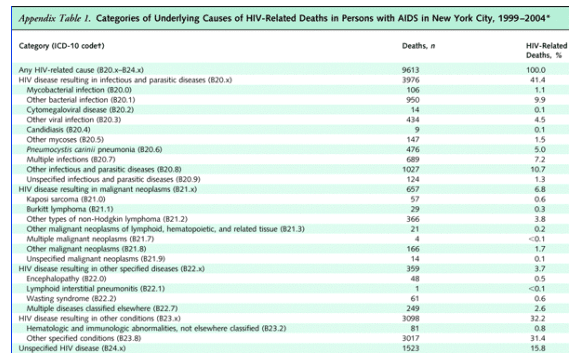
Non-HIV-Related Underlying Causes of Death
We classified deaths with a known underlying cause that did not meet the criteria described earlier as non-HIV-related. We further classified underlying causes into 9 major categories based on those used by the New York City DOHMH Office of Vital Statistics (27). Appendix Table 2 shows these categories and their associated ICD-10 codes. The substance abuse category included heterogeneous conditions that were associated with alcohol and drug abuse, including drug dependence (that is, overdose), alcoholic liver disease, cirrhosis, hepatitis C, and liver cancer (27-32). The cardiovascular disease category comprised all ICD-10 codes between I00 and I78, except cardiac arrest codes. The cancer category comprised malignant types of cancer, except liver cancer and neoplasms that are part of the CDC case definition. We further classified non-HIV-related causes into 16 specific subcategories to better characterize the cause of death.
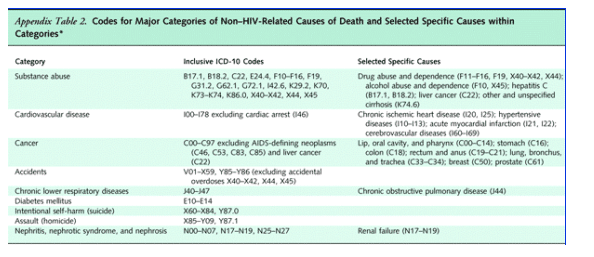
Statistical Analysis
We calculated the age-adjusted mortality rates per 10 000 persons with AIDS for each year from 1999 to 2004 and for the entire time period. Mortality rates were age-standardized to the U.S. Census population in New York City in 2000 (33). We tested trends in rates of HIV-related deaths, non-HIV-related deaths, and specific non-HIV-related causes by using linear regression models. The model that tested trends in HIV-related and non-HIV-related deaths pooled all deaths to allow for differential trends and an explicit statistical test of whether they differed. We compared crude and age-standardized mortality rates by using methods developed for mortality vital statistics (34).
We tested the association between time to death and patient characteristics in separate Cox proportional hazards regression models for HIV-related and non-HIV-related deaths. Independent variables in the model were age, sex, race or ethnicity, HIV transmission category, borough, residence in an area of poverty, year of AIDS diagnosis, and lowest CD4+ lymphocyte count. Date of cohort entry was 1 January 1999 or the date of AIDS diagnosis if diagnosis was after this date. We followed cases until death or we censored cases on 31 December 2004 if patients were still alive on that date. Those who died of a non-HIV-related cause were censored on the date of death in the model that assessed time to HIV-related death. Similarly, those who died of an HIV-related cause were censored at death in the model that assessed time to non-HIV-related death. We verified the proportional hazards assumption by using graphical and statistical methods.
We imputed missing data on HIV transmission category and CD4+ lymphocyte count by using multiple imputation techniques in Stata, version 8.2 (Stata Corp., College Station, Texas) (35-38). After we stratified by sex of the person, we imputed missing values for both HIV transmission category (men who have sex with men, injection drug user, high-risk heterosexual, or other transmission risk) and lowest CD4+ lymphocyte count category (0.049 x 109 cells/L, 0.050 to 0.199 x 109 cells/L, 0.200 to 0.349 x 109 cells/L, or 0.350 x 109 cells/L). We used multinomial logistic regression to impute HIV transmission category in cases with missing data on transmission risk, while we used ordinal logistic regression to impute CD4+ lymphocyte category in cases with missing CD4+ lymphocyte counts. Multiple imputation has been explored in depth for CD4+ lymphocyte counts in studies of persons with AIDS (39). We conducted sensitivity analyses using alternative methods of reconciling missing data for HIV transmission category and CD4+ lymphocyte count, including listwise deletion and fitting dummy variables for missing data.
We used SAS, version 8.2 (SAS Institute, Cary, North Carolina), and Stata, version 8.2, for the analysis.
Role of the Funding Source
Our analysis was supported through a cooperative agreement between the New York City DOHMH and the CDC. The funding source had no role in the design, analysis, or interpretation of the data or in the approval of the manuscript.
Results
Persons with AIDS in New York City between 1999 and 2004
Of 68 669 persons with AIDS who were 13 years of age or older and were living in New York City between 1999 and 2004, the median age was 46 years, 69.9% were men, 46.9% were black, 33.4% were Hispanic, and 18.2% were white (Table 1). Among men with a known transmission category, 44.8% had sex with men and 44.5% used injection drugs. Among women with a known transmission category, 48.3% used injection drugs and 47.4% had high-risk heterosexual sex. At the time of AIDS diagnosis, 60.3% of persons lived in areas of poverty.
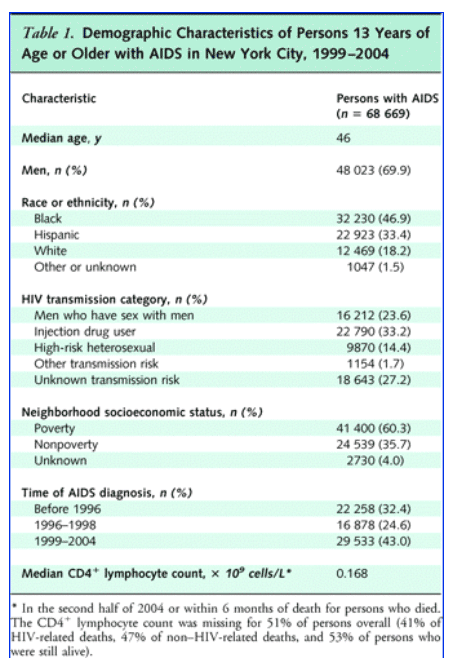
Trends in Deaths of Persons with AIDS
In New York City between 1999 and 2004, 12 715 deaths with known causes occurred among persons with AIDS: 9613 were HIV-related deaths and 3102 were non-HIV-related deaths (Figure). The rate of HIV-related deaths decreased by 54.9% (from 458 deaths per 10 000 persons with AIDS to 206 deaths per 10 000 persons with AIDS), an average decrease of 49.6 deaths per 10 000 persons with AIDS (95% CI, 38.9 to 60.4 deaths per 10 000 persons with AIDS; P < 0.001) annually, whereas the rate of non-HIV-related deaths decreased by 34.3% (from 120 deaths per 10 000 persons with AIDS to 79 deaths per 10 000 persons with AIDS), an average decrease of 7.5 deaths per 10 000 persons with AIDS (CI, 4.0 to 11.0 deaths per 10 000 persons with AIDS; P = 0.004) annually. The rate of decline in HIV-related deaths was significantly higher than that in non-HIV-related deaths (P < 0.001). The percentage of all non-HIV-related deaths increased by 32.8% (from 19.8% to 26.3%; P = 0.015).
Figure. Age-adjusted AIDS mortality rate by underlying cause of death, New York City, 1999-2004.
The HIV-related mortality rate decreased by 54.9% overall, with an average annual decrease of 49.6 deaths per 10 000 persons with AIDS (P < 0.001), while the non-HIV-related mortality rate decreased by 34.3%, or 7.5 deaths per 10 000 persons with AIDS annually (P = 0.004). Mortality rates did not decrease significantly over time for the 3 leading non-HIV-related underlying causes of death (cardiovascular-, cancer-, and substance-related deaths) (P > 0.100).
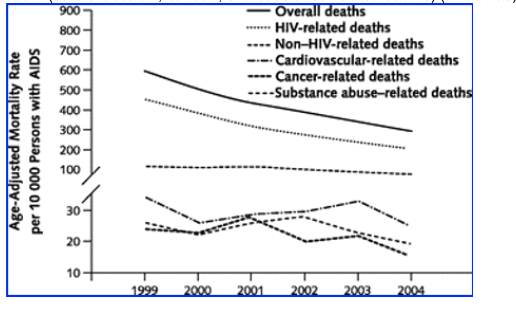
Predictors of HIV-Related Deaths
The mortality rate for HIV-related causes increased with age from 220.5 deaths per 10 000 persons with AIDS (for persons 13 to 24 years of age) to 418.4 deaths per 10 000 persons with AIDS (for persons >65 years of age) and was higher for women than for men (343.7 deaths per 10 000 persons with AIDS vs. 283.6 deaths per 10 000 persons with AIDS) (Table 2). Rates of HIV-related deaths were highest for black people (369.1 deaths per 10 000 persons with AIDS), followed by Hispanic people (289.5 deaths per 10 000 persons with AIDS) and white people or persons of other races (183.3 deaths per 10 000 persons with AIDS). The mortality rate was lowest for men who have sex with men (176.7 deaths per 10 000 persons with AIDS) and was highest for injection drug users (391.6 deaths per 10 000 persons with AIDS). In the Cox regression analysis, a CD4+ lymphocyte count of 0.049 x 109 cells/L or less (vs. >0.350 x 109 cells/L) was the strongest clinical predictor of HIV-related death (hazard ratio, 34.92 [CI, 29.86 to 40.84]). Injection drug use (vs. men who have sex with men) was the most important nonclinical predictor (hazard ratio, 1.59 [CI, 1.49 to 1.70]). Black race (hazard ratio, 1.17 [CI, 1.09 to 1.25]) and female sex (hazard ratio, 1.19 [CI, 1.13 to 1.26]) had a small but statistically significant association with HIV-related death. With respect to age, risk was highest for persons 65 years of age or older (vs. those 35 to 44 years of age; hazard ratio, 1.44 [CI, 1.28 to 1.62]).
Predictors of Non-HIV-Related Deaths
The mortality rate for non-HIV-related causes increased with age from 19.4 deaths per 10 000 persons with AIDS for persons 13 to 24 years of age to 268.9 deaths per 10 000 persons with AIDS for those 65 years of age or older (Table 2). Black people had the highest non-HIV-related mortality rate (115.4 deaths per 10 000 persons with AIDS) of any race or ethnicity. The mortality rate was lowest for men who have sex with men (55.3 deaths per 10 000 persons with AIDS) and was highest for injection drug users (158.6 deaths per 10 000 persons with AIDS). The rate of non-HIV-related deaths was inversely associated with CD4+ lymphocyte count, ranging from 209.1 deaths per 10 000 persons with AIDS for persons with a CD4+ lymphocyte count of 0.049 x 109 cells/L or less to 55.8 deaths per 10 000 persons with AIDS for persons with a CD4+ lymphocyte count of at least 0.350 x 109 cells/L. In the Cox regression analysis, the strongest predictors of non-HIV-related death were advanced age (>65 years vs. 35 to 44 years; hazard ratio, 3.03 [CI, 2.61 to 3.52]), injection drug use (vs. men who have sex with men; hazard ratio, 2.54 [CI, 2.24 to 2.87]), and low CD4+ lymphocyte count (<0.049 x 109 cells/L vs. >0.350 x 109 cells/L; hazard ratio, 4.99 [CI, 4.10 to 6.08]). Female sex had a small but statistically significant association with non-HIV-related death (hazard ratio, 1.11 [CI, 1.01 to 1.21]). Black race (vs. white or other race) was statistically significantly associated with non-HIV-related death (hazard ratio, 0.83 [CI, 0.74 to 0.92]).
Leading Categories of Underlying Causes of Death
Between 1999 and 2004, HIV-related causes accounted for 74.2% of deaths of persons with AIDS (Table 3). Among deaths due to non-HIV-related causes, the 3 leading underlying causes were substance abuse (31.0%), cardiovascular disease (23.8%), and cancer (20.8%), together accounting for 75.6% of deaths. Although substance abuse accounted for the largest percentage of non-HIV-related deaths, the mortality rate was lower than that for cardiovascular disease and cancer after age standardization. Between 1999 and 2004, the mortality rate did not change significantly for these 3 causes (P > 0.100) (Figure). Other major categories of natural causes of death were chronic lower respiratory disease (2.6%) and diabetes mellitus (2.4%).
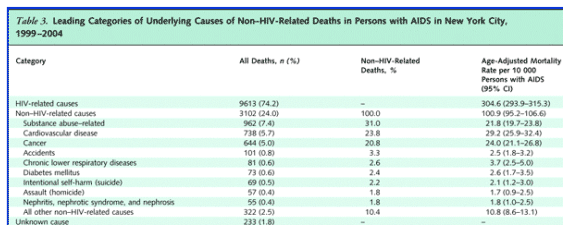
Specific Underlying Causes of Non-HIV-Related Death
Table 4 presents the age-adjusted mortality rates for the top 16 specific underlying causes of non-HIV-related death. Drug abuse and dependence (that is, overdose), chronic ischemic heart disease, lung cancer, hypertension, alcohol abuse and dependence, and hepatitis C were leading causes in most groups, although mortality rates also varied statistically significantly by sociodemographic characteristics and transmission category. For example, the rate of lung cancer-related deaths ranged from 6.0 deaths per 10 000 persons with AIDS among Hispanic people to 12.6 deaths per 10 000 persons with AIDS among black people, and the rate of drug abuse-related deaths was 8.2 times higher among male injection drug users (27.9 deaths per 10 000 persons with AIDS) than among men who have sex with men (3.4 deaths per 10 000 persons with AIDS).
Specific important causes in subpopulations were diabetes mellitus in women (4.1 deaths per 10 000 persons with AIDS) and prostate cancer in men in the high-risk heterosexual category (6.2 deaths per 10 000 persons with AIDS) (data not shown). Among women in the high-risk heterosexual category, cardiovascular disease accounted for 36.0% of all non-HIV-related deaths, primarily due to chronic ischemic heart disease (15.8 deaths per 10 000 persons with AIDS) and hypertension (9.4 deaths per 10 000 persons with AIDS). The mortality rate due to homicide in women in the injection drug user category was 17.1 deaths per 10 000 persons with AIDS. Drug abuse and dependence (overdose) was the leading underlying cause of death in 3 age groups: 25 to 34 years (11.8 deaths per 10 000 persons with AIDS), 35 to 44 years (19.0 deaths per 10 000 persons with AIDS), and 45 to 54 years (22.5 deaths per 10 000 persons with AIDS). Chronic ischemic heart disease was the leading underlying cause of non-HIV-related death in persons 55 to 64 years of age (26.5 deaths per 10 000 persons with AIDS) and in those 65 years of age or older (60.2 deaths per 10 000 persons with AIDS), followed by lung cancer (20.5 deaths and 35.3 deaths per 10 000 persons with AIDS,
respectively).
Note from Jules Levin: when looking at age groups, in the 45-54 age group: hepatitis C and liver cancer together - 10.9 deaths per 10,000 - this was the third leading cause in deaths/10,000 after substance abuse, a catch-all category (22.5 per 10,000), and cardiovascular disease, 14.8 deaths per 10,000. In the 55-64 age group the collective deaths for HCV & liver cancer was again 10.9 per 10,000).
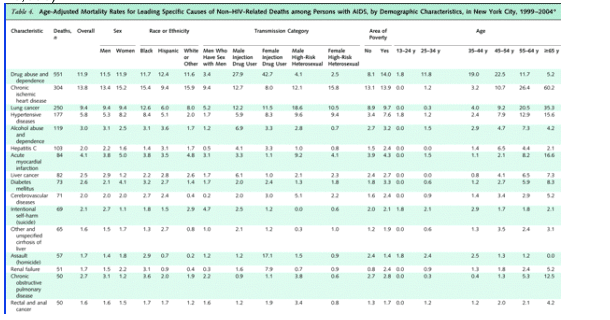
DISCUSSION
Between 1999 and 2004 in New York City, the mortality rate for both HIV-related and non-HIV-related causes among persons with AIDS decreased, continuing a trend that began with the introduction of HAART. Although HIV-related causes accounted for most deaths, the proportion of deaths due to non-HIV-related causes increased by 33% and accounted for approximately one fourth of all deaths of persons with AIDS during this period. More than three quarters of non-HIV-related deaths were due to substance abuse, cardiovascular disease, and cancer. In recognition of these trends, the IDSA has stressed the importance of managing persons who are living with AIDS according to standard practices appropriate for their age and sex, regardless of HIV status (13). Our analysis suggests that this should include helping patients change behaviors, such as smoking; screening for early detection of cancer; and monitoring chronic conditions, such as diabetes and hypertension. An aging population will also present new treatment challenges, such as the interaction between medications for chronic comorbid conditions and HAART (40).
Our findings are generally consistent with the results of other research on trends in causes of death among persons with HIV or AIDS despite differences in study population and methods (14-19). Most recently, Crum and colleagues (18) reported a statistically significant increase in the proportion of non-HIV-related causes of deaths from the pre-HAART era (9%) to the post-HAART era (32%) in a cohort of HIV-positive U.S. military beneficiaries. Our population-based analysis lends further support to the importance of this shifting paradigm. In many respects, the non-HIV-related health concerns facing an aging population of persons with AIDS are the same concerns that affect their non-HIV-infected peers (27). However, cause for concern is greater among persons with AIDS: Their mortality rate may be higher due to higher prevalence of smoking (41-45) and substance use (46), and a low CD4+ lymphocyte count seems to confer an independent increased risk for death for many conditions (47). Interventions for achieving substantial decreases in non-HIV-related deaths among persons with AIDS are similar to those required in the general population (48). Smoking cessation programs, for example, could substantially reduce deaths from cardiovascular disease and lung cancer (49-51). Linkage to substance use treatment programs can immediately affect the 21% of non-HIV-related deaths among persons with AIDS due to acute alcohol and substance use (52).
We believe that our analysis is the most comprehensive description of non-HIV-related causes of death among persons with AIDS in the United States. It would be difficult to replicate the analysis nationally because it requires matching names from HIV/AIDS and vital statistics registries, which are available only at the state and local level. Among U.S. cities and states, New York City has the largest HIV and AIDS epidemic, with more than 60 000 persons living with AIDS and 2000 deaths among persons with AIDS annually. The epidemic is also heterogeneous with respect to age, sex, race or ethnicity, and HIV transmission category, and thus, we can describe the similarities and differences among groups.
An analysis on this scale was feasible because we used death certificates to ascertain the underlying cause of death. Compared with autopsy and chart review, however, death certificates have some well-recognized limitations. Lack of specificity in the underlying cause is a problem. For example, 70.9% of HIV-related deaths were not assigned a specific cause, limiting the usefulness of this data source for examining trends in individual HIV-related conditions and intervening to reduce preventable deaths due to opportunistic illnesses, such as Pneumocystis (carinii) jiroveci pneumonia, that have effective prophylaxis and treatment. For this reason, chart review studies that provide detailed clinical information on the cause of death and antiretroviral therapy are an important complement to a population-based analysis like ours. Misclassification of the underlying cause due to omission of HIV from the death certificate is another possible limitation (53). Because everyone in our population had documented HIV infection, we incorporated HIV infection into the ICD-10 algorithm for determining the underlying cause of death and we reclassified 385 of 12 715 (3.0%) deaths from non-HIV-related to HIV-related (26). Finally, the ICD-10 rules for coding the underlying cause of death have been challenged for missing HIV-related deaths in some instances, such as HIV-related nephropathy, and overcounting them in other instances, such as viral hepatitis (26). Controversy notwithstanding, the ICD-10 rules are public, transparent, and reproducible, thus allowing comparisons of causes of death over time and across populations and geographic areas.
A further limitation of surveillance data is the dependence on chart review as the source of most information and, therefore, the high rates of missing data for certain variables. Data on HIV transmission category and CD4+ lymphocyte count were missing for 27% and 51% of persons with AIDS, respectively. We used multiple imputation techniques to assign a range of likely values when values were missing. These techniques are based on the assumption that the values are missing at random (35, 36). With respect to transmission risk, we have some concern about whether this assumption is met, because same-sex behavior can often be hidden from health care providers in ways that injection drug use usually cannot, resulting in higher levels of missing risk information in men who have sex with men. Nonetheless, the multiple regression results based on statistical imputation did not differ in important ways from those of other approaches we tested, including listwise deletion and creation of a dummy variable for missing values, which is reassuring.
Although non-HIV-related deaths account for an increasing proportion of deaths of persons with AIDS, the absolute rate of non-HIV-related deaths has decreased. One explanation for this is the effect of HAART on non-HIV-related causes of death. The age-adjusted rate of non-HIV-related deaths was 3.7 times higher among persons with a CD4+ lymphocyte count of 0.049 x 109 cells/L or less than among persons with a CD4+ lymphocyte count of 0.350 x 109 cells/L or greater. In an international study, CD4+ lymphocyte count was inversely associated with liver-related deaths, non-HIV-related malignant conditions, and heart disease (to a lesser extent) (47). Thus, as the immune status of many persons with AIDS has improved because of HAART, an unintended benefit may be lower mortality rates from non-HIV-related causes as well as HIV-related causes.
In our population-based analysis of deaths among persons with AIDS in New York City, the proportion of deaths due to non-HIV-related causes increased by 33% between 1999 and 2004. Most of the non-HIV-related deaths were due to substance abuse, cardiovascular disease, and cancer, and many of them were preventable. Achieving reductions in non-HIV-related deaths may require a shift in the health care model for persons with AIDS from a primary focus on managing HIV infection to providing care that addresses all aspects of physical and mental health.
|
|
| |
| |
|
|
|